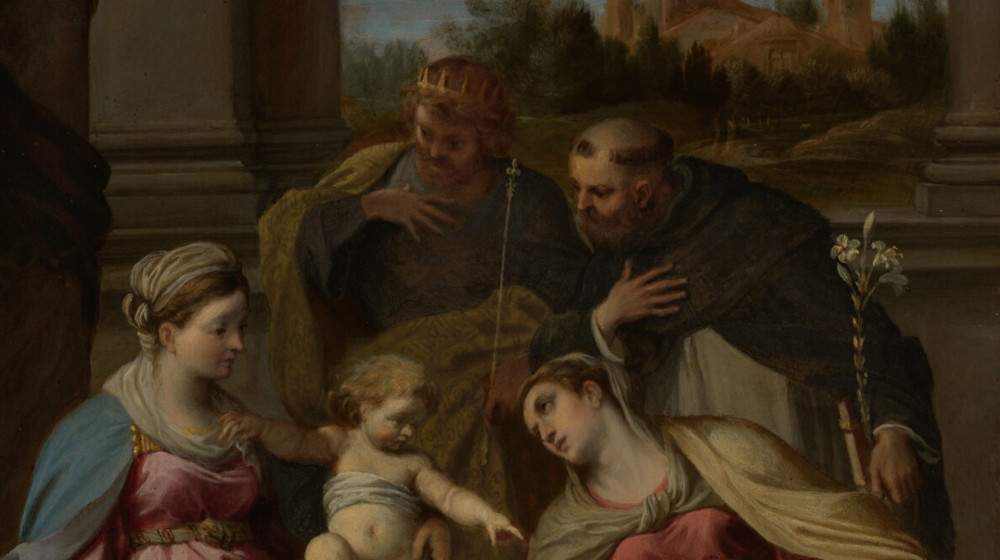The J. Paul Getty Museum has announced two important acquisitions: these are the Codex of Irmengarda, a manuscript made for the 11th-century noblewoman Irmengarda of Nellenburg, of the House of Egisheim-Dagsburg in Germany, and a painting by Annibale Carracci depicting the Madonna and Child with St. Lucy, St. Dominic and St. Louis of France.
“These two acquisitions bring fundamental contributions to the landscape of medieval Northern European miniature painting and to our already rich holdings of 17th-century paintings,” said Timothy Potts, director of the Getty Museum. “The Codex of Irmengarda, with its extraordinarily rich body of images, is a spectacular example of an early medieval manuscript miniature, a genre that has not appeared on the market for more than half a century. And along with Caravaggio, Hannibal was one of the first instigators of the Baroque movement in Italian art.”
The Codex of Irmengarda was made in Germany in the mid-11th century. The manuscript contains fifteen full-page miniatures executed in the colors of pink, blue and lavender that characterize the painting of the so-called long Ottonian era. The Ottonian Empire was named after three consecutive emperors named Otto, who ruled in the 10th and early 11th centuries, but the cultural era continued in the reign of the Salian emperors, who ruled the Germanic lands from 1024 to 1125. Irmengarda of Nellenburg was a member of a powerful local ruling family, the House of Egisheim-Dagsburg. She was related to Pope Leo IX (1002-1054) and was the niece of the Ottonian emperor Henry II (973-1024).
The text of the Codex of Irmengarda is thought to have been written around 1030-1050. The full-page miniatures were added shortly after 1053 at Irmengard’s behest. The strikingly beautiful miniatures include portraits of the four evangelists and images highlighting the most important feasts of the Christian calendar. Miniatures such as the Annunciation and the Three Marys at the Sepulcher are designed as two pages side by side, with the scene spanning both pages to form a single composition. This narrative device was also used in the final two pages with Irmengarda and her husband offering the book itself to Christ and St. Michael.
“The Codex of Irmengarda represents the centerpiece of the Reichenau School period, in which powerful, theatrical figures underscore the majesty of the events they enact,” says Elizabeth Morrison, senior curator of manuscripts at the Getty Museum. “Since the 1980s we have not been able to add any items from this remote era to the collection, so it is impossible to overstate the historical rarity of this acquisition.”
The manuscript will be displayed in an upcoming exhibition in fall 2023.
In Annibale Carracci’s small painting, the painter creates an intimate and monumental composition. The Virgin sits on the left, wrapped in the traditional blue mantle and red dress. Baby Jesus sits precariously on a silk cushion placed on his mother’s lap. St. Lucy kneels before the Virgin and Child dressed in red with a yellow mantle and white veil covering her head. Behind her, two other saints, St. Louis of France and St. Dominic, devoutly watch the scene. The scene is painted in warm golden sunlight and opens against a landscape background.
The painting represents the painter at the height of his artistic maturity, when he moved to Rome in 1595 to fresco Palazzo Farnese.
“Annibale Carracci is one of the creators of the visual language of the Baroque with his emphasis on gestures and emotions,” says Davide Gasparotto, senior curator of paintings at the Getty Museum. “He executed a handful of paintings on copper intended for discerning patrons. This painting, although small in size, is quite ambitious in terms of composition and perfectly encapsulates the style that Hannibal developed after moving to Rome from Bologna in 1595.”
The acquisition expands a group of other copper paintings in the collection including Domenichino’s The Road to Calvary and Bernardo Cavallino’s The Shadow of Samuel Invoked by Saul. The painting also complements a small selection of works on paper by Annibale and his brother Agostino Carracci in the museum’s drawing collection.
The painting will go on display at the Getty Center in April 2023.
Image: Annibale Carracci, Virgin and Child with Saint Lucy, Saint Dominic and Saint Louis of France, detail (c. 1596-1598; oil on copper; Getty Museum)
 |
| Getty Museum acquires an important early medieval manuscript and a painting by Annibale Carracci |
Warning: the translation into English of the original Italian article was created using automatic tools. We undertake to review all articles, but we do not guarantee the total absence of inaccuracies in the translation due to the program. You can find the original by clicking on the ITA button. If you find any mistake,please contact us.